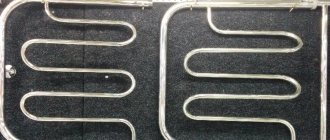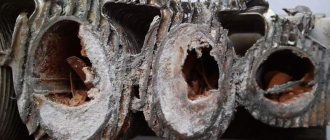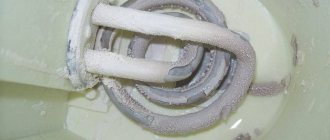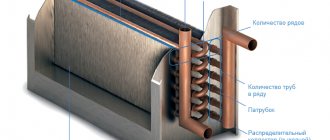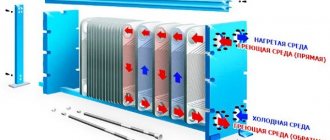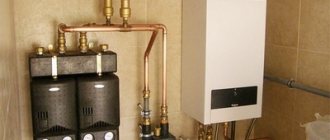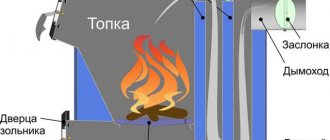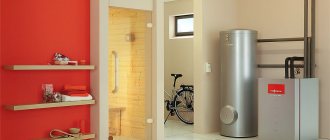When is boiler cleaning necessary?
As a rule, these are 3 situations:
- Preventative cleaning of the boiler every 2 years, with minimal costs.
- Cleaning is carried out as the heat exchanger becomes contaminated with soot and lime deposits. At the same time, the efficiency of heating and water heating decreases. You can call a specialist, but the option of cleaning it yourself is also possible.
- Heat generator failure. Unfortunately, this situation is not uncommon at the height of the heating season. A specialist will be called to fix the problem. It also cleans the heat exchanger from soot.
As you can see, the last two scenarios are unattractive for home owners. They are associated with additional costs and discomfort. You cannot do without a specialist even if a condensation-type boiler with a specially designed burner is used to heat the room. It is not advisable to repair such complex equipment yourself. The exception to this rule is if you are well versed in this technique.
Preventing clogging
There are ways to extend the service life of bithermal heat exchangers:
- Self-cleaning of units. To do this, the owner will need a booster pump and a special substance. Since there is no need to disassemble the boiler, the operating time is about 15-20 minutes. The disadvantage of this method is the use of aggressive substances, which, if handled carelessly, can cause harm and break the tightness of the equipment, which is very difficult to restore. Using “folk” remedies such as citric acid for cleaning will be ineffective.
- Carrying out washing of units at the service center. This option is preferable, as it is carried out by specialists. The procedure restores the operation of the heating device and ensures the prevention of unforeseen situations or equipment breakdown. To do this, they use effective but gentle means.
Maintenance of gas boilers Source lscomplex-bud.pl
You need to resort to cleaning in the following cases:
- Prevention. It is carried out on average once every few years. Experts advise doing it annually if possible.
- On-demand cleaning. It is recommended to carry it out if there is a decrease in the efficiency of the boiler.
- Heat generator failure. In such a situation, it is recommended to combine repairs with cleaning of components.
Installing a bithermic heat exchanger on a gas boiler Source greentravaux.fr
Criterias of choice
The first difference between gas boilers is that, as a complete review of gas heating boilers shows, there are boilers with an open combustion chamber, and others with a closed combustion chamber. In boilers with an open combustion chamber, combustion products are thrown into the chimney due to the draft that is present in it. Oxygen, without which the combustion process is impossible, is taken from the room in which the boiler is located. Before choosing a gas heating boiler, you should consider that a boiler with an open chamber can only be installed in a room where there is good ventilation.
The coaxial chimney is a “pipe-in-pipe” type structure. Fresh air enters through the outer chimney pipe, and exhaust gases are discharged through the inner pipe. When choosing a gas heating boiler, you should know that in the case of boilers with a closed combustion chamber, air comes from the street, so such a boiler can be installed even in an unventilated room.
Based on such criteria as exhaust gas removal, models of gas heating boilers can be divided into the following types: parapet, chimney and turbocharged.
- A parapet boiler is a unit with a closed combustion chamber in which exhaust gases are released naturally.
- A chimney boiler is a unit with an open combustion chamber.
- A turbocharged boiler is a boiler with a closed combustion chamber.
The release of exhaust gases in such boilers occurs forcibly. To exhaust exhaust gases, turbocharged gas heating boilers are equipped with a built-in fan.
Gas boiler heat exchanger material: which is better
It surprises me when people don’t think about the material from which the heat exchanger in the boiler is made. After all, this is one of the most important elements of heating equipment. The efficiency, heating rate and, most importantly, service life depend on the material. In addition, they may contain a second circuit. So that you understand which heat exchanger is better, I want to talk about the advantages and disadvantages of each of them.
The first cast iron heat exchangers
Almost eternal, corrosion and scale resistant cast iron heat exchanger.
It was cast iron that was used to create the first coal and gas boilers. This is due to its anti-corrosion properties and service life of 30 to 50 years. And in general, cast iron has little effect on any chemicals. But as for the heat capacity, it is one of the highest. Therefore, even now, when many other types have appeared, cast iron heat exchangers continue to be in demand. They take longer to heat up, but also retain heat much longer after heating stops.
Unfortunately, they have more disadvantages. Firstly, it is huge weight and dimensions. Boilers with cast iron heat exchangers take up a lot of space, and it is not at all possible to hang them on the wall. Only the floor installation method, massive powerful boilers are demanding on the floor covering (their weight often exceeds 300-400 kg).
Secondly, they do not tolerate sudden temperature changes. But in heating, the return is always colder than the supply. Thirdly, in order to protect cast iron from these changes, they began to use special burners. And then heat capacity ceased to be an advantage. Therefore, in fact, the only advantage is a long service life.
Steel
To get rid of the disadvantages of cast iron, they began to use steel heat exchangers. They are lighter, the equipment takes up less space, and the price is much lower. In addition, steel heat exchangers are not so afraid of temperature changes, so they are very suitable as a heating element. And if they break, they can be repaired. Of course, not all models, but many.
Why then do cast iron heat exchangers continue to be used if steel ones have so many advantages? The fact is that not everything is so smooth. After all, steel is susceptible to corrosion, and this is a huge disadvantage. Therefore, the service life is 2-3 times less, usually from 12 to 15 years
I would also like to draw your attention to the fact that steel can burn out. If you decide to choose a boiler with a heat exchanger made of this material, I advise you to find out in advance about the wall thickness
It should be 3 mm or more. Or better yet, 5 mm.
Copper
The best metal in terms of heat transfer characteristics is copper. Perhaps, we can name only one disadvantage of copper heat exchangers. This is their high price; copper heat exchangers are usually installed on models in the mid-price segment and above (from 45-50 thousand rubles). But there are a lot of advantages:
- compact dimensions;
- light weight;
- high efficiency;
- copper is practically resistant to corrosion;
- heats up and cools down quickly;
By the way, it is precisely because of the rapid heating that much less gas is wasted, so savings can be considered another advantage. As for the service life, manufacturers usually indicate 14-17 years, which corresponds to reality. This is slightly more than steel, but still much less than cast iron. But during this time you will be able to save much more on fuel.
Aluminum
Aluminum is also used as a material for the heat exchanger of a gas boiler. It was first used in condensation models, but I will talk about them a little later. Aluminum heat exchangers are also installed in conventional convection boilers. It would seem, why are they needed if copper copes well with its tasks? It's all about the price. To reduce the cost of production, in copper heat exchangers they try to reduce the wall thickness. There is no need to do this with aluminum. It is already several times cheaper than copper, and its heat transfer properties are also quite high.
It turns out that the aluminum heat exchanger is thicker than the copper one. And this is its huge advantage, because the service life increases. Practice has shown that aluminum is also less susceptible to oxidation. But on the Internet, opinions on this matter differ. Therefore, it is difficult to say exactly which heat exchanger is better.
How does a bithermal heat exchanger work?
The operating modes for heating and hot water supply have several differences. In the first case, standard heating of water occurs during the combustion of gas - if we are talking about the same gas boilers, for example. That is, in heating mode, the coolant is directly heated, which then circulates along its circuit. As for the operating mode in the DHW format, this function is in some way secondary. The primary heating of the coolant also occurs, and from it the heat is transferred to the sections with water intended for hot water supply. In this case, heating water is not distributed through the corresponding circuits - it remains in its section. For almost all bithermic boilers, one rule applies - only one of the two circuits can operate at the same time. Simultaneous circulation of water for heating and hot water supply is unacceptable.
Operating principle of the equipment
The operation of a bithermic heat exchanger looks like this:
- First, the plate heats up, transferring heat to the outer tube with gradual heating of the water in the compartment, which is intended for heating. While the hot water supply tap is not turned on, the second circuit is closed, the heated liquid circulates inside the first circuit.
- If you turn on the hot water supply, the heating circuit is automatically shut off, and the second one is started accordingly. All the heat passes to the second circuit, and the heating water begins to circulate in the internal compartment. When the hot water grana is closed, the flow of water in the outer cavity is resumed.
Replacing a heat exchanger in a gas boiler Source theguardian.com
How to clean a gas boiler from scale Procedure
To disassemble a heating unit at home, you do not need any special tools. A DIY kit with pliers, screwdrivers and keys is quite enough.
The algorithm of actions to effectively clean the heat exchanger of a gas boiler is as follows:
- Disconnect all wires from the gas valve.
- Remove the thermocouple from the combustion chamber. It is connected to the gas valve using a capillary tube.
- Disconnect the gas fuel supply pipe.
- Unscrew the four nuts that hold the stove with the burner.
- Now it’s the turn of the heat exchanger. To gain access to it, remove the top cover of the boiler, disconnect the chimney pipe and the draft sensor.
- After this, carefully remove the insulation, and then unscrew the screws securing the casing and remove it.
- A heat exchanger is located under the casing. Remove the turbulators from it.
- You can clean steel turbulators using a wire brush. And the heat exchanger itself can be cleaned using simple tools that you make yourself, in accordance with the size of the smoke pipes.
- After cleaning is completed, sweep the surfaces of the heat exchanger using a brush that is screwed to the handle.
- The last stage of cleaning is to clear the bottom of soot that has fallen off during the cleaning of the smoke pipe.
How to clean a heat exchanger using a booster
This procedure requires skill and compliance with certain safety rules:
- All system connections must be as tight as possible to avoid contact of chemically active substances with the skin or eyes.
- The washing solution must be prepared only while wearing protective equipment (gloves and, if required, goggles).
Now you can start cleaning the heat exchanger using a booster. To do this, you will need a low-power pump, for example, from a washing machine or heating system, and a device, the manufacturing sequence of which was indicated above. The pump should be connected to a container, into which at least 6 liters of water should then be poured. Before this, the water is heated to a temperature of at least 50 degrees.
After the preparatory stage, the hoses from the tank are connected to the inlet and outlet of the heat exchanger and the pump is started. It is enough to circulate the liquid through the system once and turn off the pump. Now you need to carry out a thorough inspection to make sure that the system is highly tight. If no leaks or drops of water are noticed anywhere, then the cleaning can be carried out fully.
A special solution is added to the system and the pump is started for at least 40 minutes. It should be remembered that both the main and secondary heat exchangers require thorough washing. Then the total time should be at least 1 hour 20 minutes (40 minutes for each lap).
After the cleaning agent has been circulated through the system for a specified time, the booster can be turned off and a hose from a centralized water supply tap can be connected to the heat exchanger terminals. 3-5 minutes are enough, and the device can be reinstalled on the gas boiler.
The video shows how to flush the primary and secondary heat exchanger of an Ariston boiler using a booster.
Washing using booster and hydrochloric acid.
General information about bithermic heat exchanger
Classic heat exchangers for boilers provide for the separation of heating chambers. That is, one chamber is intended for servicing heating circuits - usually the main one, and for hot water supply - a secondary radiator. This design has many advantages, however, against the backdrop of combined heating chambers, its weaknesses also become obvious. In this case, it would be incorrect to assume that in the second case the water is mixed - this principle does not allow a bithermic heat exchanger. What is this in terms of approach to water maintenance? This is the same radiator equipment, but with a common housing, which contains both chambers for heating the coolant and compartments for preparing domestic water. In bithermal systems, the principle of separating service areas of different environments also applies, but this applies specifically to the internal delimitation of chambers. While a standard split heat exchanger initially contains two different chambers.
Plate heat exchanger
It consists of 2 heat exchangers: for heating water - primary, for heating hot water - plate or secondary.
Advantages of the plate unit:
These units are the most popular on the market. Their key advantages:
- Easy to maintain. To clear the blockage, the device should be disassembled, washed, and reassembled. Even a non-specialist can perform such a manipulation.
- Minimal risk of unit contamination due to corrugation and polishing of the plates
- Cost-effective and durable. Such a device can last up to 20 years with proper and competent use.
Disadvantages of a plate heat exchanger
It would be an exaggeration to say that this unit is more repairable. Boilers with bithermal and plate heat exchangers are equally susceptible to scale and other deposits. It is impossible to guarantee with 100% probability that by purchasing a separate unit, you will be protected from this problem. We repeat, it all depends on the operating conditions.
A significant disadvantage of this plate device is that hot water must wait until it heats up in the primary heat exchanger. This especially applies in the summer when there is no heating.
Advantages of bithermic units
The advantages of heat exchangers with a single block extend to both heating efficiency as such and ease of control, not to mention the higher reliability of the units. As for efficiency, bithermic radiators operate with a lower heat loss coefficient. If a system divided into two blocks requires heating of two blocks, then in this case the filling of one housing is serviced - accordingly, the volume of heat generated increases. In terms of control, a bithermal heat exchanger is more profitable for the same reason. Thermostats are guided by the indicators of one solid block, which affects the accuracy of the data obtained. Reliability, in turn, is achieved by minimizing the connecting infrastructure - in fact, only a connection between the heat exchanger and supply channels is required.
Types of gas boilers
According to the principle of operation, gas boilers are divided into two groups:
- convection;
- condensation
The first group of boilers is considered traditional equipment that produces heating by burning gas, while part of the heat is lost along with smoke waste. The operating principle of such a boiler is simple, understandable, and the price is relatively low.
The second type of boilers was developed using new technologies that make it possible to more fully utilize the combustion heat of gas. This allows you to obtain an efficiency that is approximately 15-20 percent higher than that of the convection model. This means corresponding fuel savings and cheaper heat. However, it is significantly higher than that of convection.
Many European and world-class companies are engaged in the development and production of gas boilers. Almost all modern models are equipped with a reliable automated protective system that does not require manual control, which is responsible for supplying fuel and maintaining the temperature in a given mode. Models equipped with a gas pressure controller are guaranteed against overheating, fire and other similar breakdowns, since it will immediately stop the gas supply in the event of a decrease in pressure, fuel leakage or flame failure.
2013-01-23 10 529
In many European gas boilers, a bithermal heat exchanger is installed. Judging by the assurances of manufacturers, this reduces production costs and practically does not affect the heat transfer and efficiency of heating equipment.
On the contrary, you can find many articles on the Internet warning against purchasing boilers with a bithermic heat exchanger. To understand where the truth is, you need to learn about the design and operation features of the device.
Which boiler to choose with a bithermic or plate heat exchanger?
Home > Articles > Which boiler to choose with a bithermal or plate heat exchanger?
04/06/2014
We would like to start our article with the following: 1. Our company deals with gas boilers from the Italian company Immergas, and we will give an example using boilers from this manufacturer.
2. We would like to note that Immergas produces a wide range of household wall-mounted gas boilers, there are more than 80 models. And the Immergas company has in its model range such boilers as with a bithermic heat exchanger, and boilers with two heat exchangers. You can choose any model that you prefer:
EOLO Star 24 3E – boiler with one heat exchanger EOLO Mythos 24 2E – boiler with two heat exchangers
3. There are ignorant or unscrupulous sellers in our markets. They scare people with various photographs and samples of damaged heat exchangers, both bithermal and plate (secondary heat exchanger). Heat exchangers break and clog regardless of their design. Heat exchangers become clogged with scale only when the boiler is used incorrectly, and it does not depend on the design of the gas boiler (with one or two heat exchangers). Therefore, we will simply tell you why we chose boilers with a bithermic heat exchanger and its advantages.
4. We will immediately show photographs of boilers with two heat exchangers, so that questions do not arise that problems do not arise in a boiler with two heat exchangers. And they don’t get clogged with scale, only in the sellers’ stories ;).
Based on our experience, we recommend boilers with a bithermic heat exchanger. Advantages of boilers with a bithermic heat exchanger: 1. Faster preparation of hot water + higher efficiency for the preparation of hot water. In a boiler with a bithermic heat exchanger, hot water is heated directly by the burner flame, which contributes to faster heating of water, saving gas and electricity than in boilers with two heat exchangers.
In a boiler with two heat exchangers, in order to heat hot water, it is necessary to first heat the primary heat exchanger (for heating), when it, in turn, heats up, only then will it heat the hot water in the secondary heat exchanger. This leads to significant consumption of water, electricity and gas. Increases waiting time and inconvenience.
The efficiency of a boiler with one heat exchanger is 93.4% The efficiency of a boiler with two heat exchangers is 91.7%
2. More comfort when controlling water temperature . Since in a boiler with one heat exchanger, the burner flame directly heats the heat exchanger for preparing hot water, temperature control is more accurate and faster. Also, such boilers adapt much faster to changes in incoming cold water (temperature, flow, pressure).
Now, imagine: the cold water entering the boiler has changed in temperature (flow, pressure), then the boiler with one heat exchanger instantly reacts and changes the flame to heat it up. In order to adapt to new conditions, a boiler with two heat exchangers initially needs to change the water temperature in the primary heat exchanger (heating), and only after that the temperature in the secondary heat exchanger begins to change, and this leads to great discomfort.
3. More reliable design. The simple but very reliable design of a boiler with a bithermal heat exchanger is associated with the absence of such unreliable components as a three-way valve and a secondary heat exchanger. Fewer parts improve the reliability of the boiler without losing comfort and efficiency.
If scale begins to form in the heating circuit (due to improper operation of the boiler), that is, there is a possibility of scale particles coming off the heat exchanger, then: In a boiler with two heat exchangers, these pieces of scale will fall directly into the secondary heat exchanger, thereby there is a high probability of breaking it, you will have to buy new secondary heat exchanger (its cost reaches 150 euros). In a boiler with a bithermic heat exchanger, this situation cannot happen, since there is no secondary heat exchanger, and pieces of scale will go into the heating system, thereby not damaging the boiler.
4. More accessible service. A boiler with a bithermal heat exchanger can be washed and cleaned without any problems if scale forms. In a boiler with two heat exchangers, it is practically impossible to wash the secondary heat exchanger, due to its design: such heat exchangers consist of a set of plates, the distance between which is 2-3 mm, and there is a high probability that when washing the heat exchanger will clog even more (its cost reaches 150 euros).
5. More affordable price for a boiler with a bithermal heat exchanger. Boilers with a bithermic heat exchanger are 10 - 15% cheaper. This is due to the absence of components such as a three-way valve and a secondary heat exchanger.
Myths about the bithermal heat exchanger: 1. The disadvantage of the bithermic heat exchanger is that heat transfer in hot water supply mode is limited. Taking the passports for a boiler with a bithermic heat exchanger and a boiler with two heat exchangers, you can see the following: That one and the second boiler prepare hot water in the same way. At Δt=30°C the boilers can produce 11.1 liters/minute of hot water. This is enough to simultaneously use two disassembly points. Thus, we see that the boilers do not differ in hot water productivity.
2. There are constant changes in hot water temperature. A modern boiler has a function: smooth flame modulation. This allows the boiler to accurately maintain the water temperature at a given value, and quickly and clearly respond to changes in water temperature and its flow. Thus, you will always have hot water at the set temperature, regardless of the incoming cold water temperature and hot water flow.
3. The process of salt deposition (scale) occurs more intensively. Thanks to the functions: - smooth flame modulation - post-circulation of water function - heat exchanger cooling function - anti-scale protection - anti-scale magnet The formation of scale in the hot water circuit is almost exactly zero. Only Immergas company gives a 5-year warranty on the bithermic heat exchanger, in case of scale formation in the circuit of the hot water preparation system.
Often competitors (or simply untrained sellers) show these photographs:
Let's look at this photo in more detail:
1. This was originally a heat exchanger from a budget manufacturer and they saved money on it. At Immergas, the heat exchanger consists of 6 tubes. This has the advantage that the heat exchange area is larger, and therefore it does not need to be installed closer to the burner flame, unlike heat exchangers with 4 and 5 tubes, where the heat exchange area is much smaller, and it is necessary to obtain boiler power in both cases - 24 kW. Accordingly, the temperature of the flame, which heats the walls of the heat exchanger, is lower.
Conclusion: the more the heat exchanger walls are heated, the higher the temperature inside its tubes, the faster and more intensively scale forms.
2. Scale formation occurs simultaneously over the entire area of the heat exchanger (it is heated evenly by the burner flame), as for example, in the photograph with a separate heat exchanger, this can be seen.
Conclusion: the photograph of the bithermic heat exchanger shows that only one tube is clogged. Accordingly, this is not caused by the natural formation of scale, but by other problems (we will look at them below).
3. Scale formation along the heating circuit. The boiler operates in a closed heating system. The water there becomes “dead” over time. When it is heated, scale does not form on the walls of the heat exchanger in the future. If the heat exchanger in the heating system is clogged, this is due to: a. The primary factory defect of the heat exchanger is water leakage from the heat exchanger tubes. b. Defects in the heating system, due to poor installation of the heating system - water leakage in pipes, expansion tank, radiators, etc. In both cases, you have to constantly replenish the heating system with new fresh water. And if this is done constantly, then scale will form on the walls of the heat exchanger, which will lead to complete blockage in the tubes. And this does not depend on the design and type of heat exchanger. If you have to constantly recharge the heating system or increase the temperature of the heating and hot water, then immediately call the service for diagnostics.
4. Why is the DHW circuit clogged? Initially, scale formation occurred in the heating circuit - the heating circuit began to clog, and when the heating circuit ceased to be a “cushion” between the burner flame and the hot water circuit, the hot water circuit gradually began to clog, as the flame began to heat the hot water circuit directly. .
Subscriber error: 1. Constantly fed the heating system and did not call the repairman. 2. I did not do the annual maintenance of the boiler, during which the technician checks the flow of water through the hot water supply. He also asks how the heating system worked in winter. 3. Constantly increased the temperature of the heating (the radiators heated less) and the hot water (it gradually became colder). How was it necessary to suffer and not respect yourself? - Call a specialist for replacement and repair, only until the passages are completely clogged. In this situation, the heat exchanger only needs to be replaced.
Conclusion: If you are shown a heat exchanger clogged in the heating circuit and at the same time in the hot water circuit, then this is the reason in the heating circuit, but not in the hot water preparation system. When a heating system circuit becomes clogged, it is usually the subscribers themselves who are to blame for not wanting to call for service or find a leak in the heating system. And no matter what heat exchanger or boiler brand you install, the result will be the same.
When you open a hot water tap, boiling water comes out and you can get scalded. The boiler has a temperature setting mode. And the hot water will not be higher than the temperature set on the boiler. The maximum temperature can be set to 55 °C. But there is a difference in the preparation of hot water in boilers, only during the heating season: - In a boiler with a bithermal heat exchanger, hotter water first flows (but not more than 55 ° C in winter, when the heating system is operating), then it decreases to the set value. — In a boiler with two heat exchangers, it slowly heats up. The disadvantage of this heat exchanger is when the boiler is operating in summer mode and the heating system is not working. To heat water in the hot water heat exchanger, you need to wait until it heats up in the primary heat exchanger of the heating system. This is a great discomfort while waiting for hot water.
Summarizing what is written above, it is the bithermic heat exchanger that is the ideal option in terms of high quality, reliability, ease of operation and reasonable cost.
Secondary heat exchangers
A boiler for heating a house with a secondary heat exchanger is equipment with interconnected stainless steel plates. Such heat exchangers are installed in Linea, Mini kW, Major kW and Micra 2 boilers. These manufacturers think through the smallest details before deciding how to make a heating boiler. Such boilers are produced with a large heat exchange area, with high thermal conductivity of the plates, which ensures the necessary heat exchange even at a high coolant flow rate. Thanks to the flow rate, such a heat exchanger can “boast” of the absence of deposits of various hardness salts on its walls.
The design features of plate hot water exchangers differ in the direction of the flow of cold water and coolant directly towards each other. The power of such a heat exchanger depends solely on the number of plates that are connected to each other. The more of them, the higher the power and the larger the heat exchange area.
Structurally, such heat exchangers are coaxial pipes (that is, one pipe located in another), on the surface of which heat exchanger ribs are soldered - special copper plates.
The inner pipe is intended for sanitary hot water, and the outer pipe is for coolant in the heating system. When operating in heating mode, heat from the combustion gases is directly transferred to the coolant. When the boiler operates in DHW mode, the heat of the combustion gases is initially transferred to the coolant, and only after that to the DHW circuit. In this case, circulation in the heating circuit stops.
The disadvantage of this heat exchanger is one thing. In hot water operation, heat transfer is quite limited. Therefore, the amount of prepared hot water is slightly lower than in boilers in which two heat exchangers are located at once.
In conclusion, it is worth saying a few words about heat exchangers with increased capacity. They are installed in original VIP class boilers - for example, such as Eura. By design, they are six to eight liter boilers, inside of which copper coils are located almost throughout the entire volume. Such heat exchangers are often also called mini-boilers.
A hot water supply circuit passes through the walls of such a mini-boiler, and a coolant circuit passes through the coil. The advantage of such a heat exchanger is that due to the large volume of coolant in the heat exchanger, when the flow rate and temperature of the DHW water change, pulsations in the water temperature begin to smooth out right at the boiler outlet. In a word, hot water (with a stable temperature) is constantly provided at the outlet, regardless of changes in water pressure and temperature fluctuations at the inlet. In addition, heat exchangers with increased capacity allow you to use a function called “quick start”, which provides hot water immediately after turning on the tap.
Use of materials is permitted only if there is an indexed link to the page with the material.
Advantages and disadvantages
The main advantage of bithermal radiators has already been announced. They are cheaper and at the same time lose little in performance. Combining the heating and hot water circuits has virtually no effect on the heating rate of running water and at the same time does not reduce the amount of heated water. Comparing boilers of the same power from the same manufacturer, you can see that the permissible hot water consumption is practically the same.
The second aspect is the method of heating the water. Due to three or four precise fastenings of the inner tube to the outer one, the area of contact of the coolant with the heat exchanger increases. In fact, the heat from the plates is distributed not only over the surface of the outer tube, but also partially transfers to the inner tube. This increases the heating rate.
In the DHW circuit, when using only heating, the water warms up to the set heating temperature and does not take away heat until the hot water tap is opened.
As soon as the hot water tap opens, there is already well-heated water in the pipes. The heating circuit is closed, and the remaining water inside the heat exchanger additionally releases heat without preventing its transfer from the plates to the hot liquid in the internal cavity.
We recommend: DIY waste oil heating: organization options
What about the cons?
And they also exist. The complex shape of the surface inside the tubes potentially increases the rate of salt deposition. Especially if the heating temperature is set to a high temperature up to 95°C inclusive. However, this is largely a problem not of the heat exchanger, but of water preparation.
In heating, by definition, the coolant must be filled in prepared. To do this, the liquid is removed from excess salts, iron and other inclusions, or at least softened, antifreeze and other additives are added to prevent the formation of scale. Even if you do not prepare the water, it moves in a closed circuit in the heating system and over time salts leave it, the total amount of which is not replenished.
With regard to hot water, it all depends on the adequacy of the user and the presence of pre-treatment and filtration. If there is a suspicion that the water is hard and contributes to the formation of scale, then a single-circuit boiler with a large channel cross-section in the heat exchanger will be at risk.
Scale in the heat exchanger
In any case, a filter or filter station should be installed before the boiler to prevent the ingress of salts and lime into the hot water supply and, of course, into the consumer’s tap.
Another feature is the separate operation of the heating and hot water supply circuits:
- At the first moment, while the hot water is open, with the heating running, almost boiling water will flow (depending on the set heating parameters).
- The coolant does not warm up when using hot water, but water heating, even with a very small volume, still has high heat capacity and inertness. You will have to use hot water for a very long time to feel the decrease in heat in the room in winter.
But in the end we can talk about the last advantage of the bithermic heat exchanger. In summer there are no problems with obtaining hot water. The source of heat for it remains the same combustion of fuel, and there is no need to warm up the entire circuit or even a specially prepared limited bypass circuit in order to please yourself with a hot shower.
Structural device
Now it’s worth understanding the design features of bithermal radiators, which allow it to separately heat different environments. Experts characterize such structures with the concept of “pipe within a pipe” or “section within a section.” If a conventional heat exchanger assumes a set of pipes that have a hollow niche, then the bithermal device is distinguished by its internal division into several segments - these are zones in which water circulates for hot water supply and heating without mixing. And according to the classical scheme, copper fins-plates are also attached to the pipes, increasing the heat transfer coefficient. Obviously, depending on the method of integration into the target equipment, other design features of the radiator will be provided. In particular, the design of the bithermic heat exchanger of a gas boiler is oriented towards heating by a burner, so the housing can provide additional layers of protection. It is mandatory for all heat exchangers to provide safety measures against electrical short circuits. Since the circuits can interface with other utility lines, grounding and the presence of fuses in boiler stations are also mandatory.
How to clean the heat exchanger of a gas boiler
To clean the heat exchanger from scale, mechanical, chemical and magnetic cleaning methods are used. The first option is performed using a cleaning rod and scraper.
Tools can be manual or electric. The chemical option involves the use of crustacean chemicals that can loosen and dissolve contaminants.
Algorithm for cleaning the heat exchanger from scale:
- Turn off the boiler.
- Prepare liquid for flushing heat exchangers of gas boilers according to the manufacturer’s recipe.
- After complete cooling, utility networks are disconnected from it and the water is drained.
- Remove the tie rods, move the pressure plate aside and then carefully remove each plate one by one. The work is carried out with gloves so as not to injure your hands.
- When working with acid, change gloves to rubber ones.
- Prepare a container for cleaning the plates so that they are completely covered with the working solution.
- The plates are immersed in the composition for 1 hour, after which the remaining deposits are removed under tap water using a brush.
- Assembly of the cleaned structure is carried out in the reverse order.
After washing the heat exchanger, check the tightness of the boiler under the operating pressure of the coolant. All utilities, gas and electricity are connected and the equipment is started for the first time after flushing.
If a leak is detected, it is necessary to tighten the nuts or install a new gasket on the heat exchanger.
How does a bithermic heat exchanger work?
The operating principle of a boiler with a bithermal heat exchanger is as follows:
- The plates accumulate heat and heat the tubes with the coolant circulating in them. The first circuit, the main pipe of the heat exchanger, is intended for pumping liquid for the heating system, the second (diamond-shaped) for hot water supply.
- The boiler operation algorithm is as follows - until the hot water tap is opened, only the heating system coolant circulates through the heat exchanger. As soon as DHW supply is required, the central heating system is temporarily stopped.
It turns out that double-circuit gas boilers with a bithermic heat exchanger design operate on the principle of alternating heating of the heating system and hot water supply, which allows for more accurate use of the heat received from the burner.
The service life of the heat exchanger depends on several factors: the chemical composition of water for hot water supply, the thickness of the walls laid by the manufacturer. The weak point and at the same time the disadvantage of bithermic heat exchangers is the susceptibility to scale deposits inside the walls of the heat exchanger.
A heat generator with two separate heat exchangers will continue to work to heat the coolant after the DHW circuit becomes clogged. The design of a bithermic heat exchanger for a gas boiler does not provide such an opportunity. After the circuit becomes overgrown, the boiler’s operation stops completely.
How and with what to rinse a heat exchanger with a bithermal design
There are several washing methods:
- At home, the simplest method is to fill the boiler with flushing liquid and pass it through the circuit using a booster - a pump that creates pressure. The procedure takes 15-20 minutes and does not require disassembling the boiler. The disadvantage of do-it-yourself repairs is that some of the means used are aggressive and incorrect execution of the procedure often leads to loss of tightness of the heat exchanger. Eliminating leaks between circuits is quite problematic. A malfunction leads to the need to replace the heat exchanger.
- The service center provides the best service option to extend the life of the boiler and prevent its early failure. Aggressive chemicals are used during service only if it is not possible to restore throughput using milder methods.
There are several more recipes for washing the heat exchanger: using acetic or citric acid, etc. Traditional methods are ineffective and do not bring significant benefits.
Which heat exchanger is better - separate or bithermal?
Two heat exchangers, operating for hot water supply and separately for heating, are larger in diameter, so they take longer to overgrow and are less susceptible to calcium deposits on the walls.
When choosing between a separate heat exchanger or a bithermic one, another factor is taken into account. The cost of the latest device is much lower. On average, the price per boiler is reduced by about a third. Low cost is the main advantage of a bithermal heat exchanger.
If the heat exchanger is regularly cleaned, and a filtration and water treatment system is installed to feed the heating system and water supply, a bithermal boiler will last no less than an analogue with two separate circuits.
Wall-mounted boilers with separate heat exchangers
A standard boiler works as follows: using a circulation pump, the coolant constantly moves through the first heat exchanger, which is heated by the burner. Thus, hot water moves through the heating system from the heat exchanger to the radiators and back.
When there is a need for hot water supply, a special sensor gives a signal and a three-way tap directs hot water from the first heat exchanger to the second. In other words, the cold water in the second heat exchanger is heated not from the burner, but from the already heated coolant.
This method allows you to reduce heating costs due to more economical fuel consumption when consuming hot water for domestic needs.
Advantages of using boilers with separate heat exchangers:
- The maximum hot water temperature does not exceed 60 degrees. This is quite enough for any needs. In this case, the likelihood of getting burned while taking a shower is reduced to zero.
- The second heat exchanger has a long service life, as it is used less often.
- Simple design. Boilers with separate heat exchangers are easy to repair. In most cases, this can be done with your own hands, saving on the services of professional craftsmen.
- The risk of clogging is minimized. Practice shows that the need for maintenance for separate heat exchangers occurs less frequently than for bithermic ones.
We recommend: Coaxial pipe for a gas boiler: types, features and installation diagrams
Important: Despite the ease of servicing separate heat exchangers, it is better not to do this yourself if you do not have experience. It may be dangerous. In all documents supplied with heating equipment, manufacturers insistently request that you refrain from doing repairs yourself.
Flaws:
- Separate heat exchangers take up more space, as a result of which the size of the boiler may be larger than what the buyer requires.
- The boiler cannot operate without a three-way valve. Its task is to automatically redirect the water flow to the second heat exchanger when the residents of the house begin to use hot water supply. Such taps often break down and need to be replaced, which creates great inconvenience.
- The price of boilers with separate heat exchangers may be higher due to the greater number of components.
As you can see, such boilers have not only positive qualities, but also disadvantages that you definitely need to know about before making a purchasing decision.
As an example, consider the wall-mounted boiler Baxi Eco Compact 14F. This model is popular in the market due to its affordable price, compact size and good electronics.
The water heating temperature (DHW) ranges from 35 to 60 degrees. The boiler runs on natural gas and consumes 1.6 m3 of fuel per hour. Compact dimensions (700x400x298 mm) allow it to be installed in any room without special site preparation.
A boiler with separate heat exchangers Baxi Eco Compact 14F is recommended for installation in rooms with a total area of no more than 140 m2. This equipment can easily cope with operation in Russian conditions, which is confirmed by many of our clients who have purchased the Baxi Eco Compact 14F boiler.
Boilers with bithermic heat exchangers
The use of bithermal radiators in boiler systems is becoming increasingly widespread. Often, large manufacturers themselves develop model designs using their own components, including heat exchangers. One of the leaders in the segment is Immergas, which offers boilers with heat exchangers with 6 tubes. This design offers an advantage over 4 and 5 tube heat exchangers, since the expanded section can be located close to the burner flame. However, it is necessary to take into account the thermal power that the boiler will provide. The bithermal operating principle in this case is capable of producing about 24 kW and this may be excessive for private houses and large country cottages. The companies Vaillant, Navien, and Protherm are also developing bithermal units. The products of these manufacturers are distinguished not only by their modern design, but also by their functionality. Engineers strive to provide models with the ability to smoothly adjust the flame, the option of cooling the heat exchanger, etc.
terms of Use
The bithermal heat exchanger needs to be washed more often.
You should purchase a boiler with such a heat exchanger only if you are confident in the sufficiently good quality of the water used as the coolant. It is imperative to install a system of filters and softeners, because the device has low maintainability. This simple step should not be neglected in order to minimize the likelihood of needing to contact a workshop. The documentation supplied with the boiler indicates the requirements for the coolant. You need to check that the water in the area matches them.
If the exchanger fails, you must contact the service center. In practice, it sometimes turns out that repairmen take on work with such devices reluctantly and without guarantees, and in the end they have to buy a new one.
The structure easily becomes clogged with soot and limescale deposits accumulate on it. This reduces efficiency - one of its main advantages over separate options. It is advisable to periodically (every 2 years) clean the exchanger with a pressure pump. Before carrying out it, you need to consult a technical center regarding the composition of the solution and the technology of the procedure. Errors in this matter easily lead to depressurization; in such an incident, the heat exchanger needs to be replaced. It’s good if you have the opportunity to invite a specialist to your home - this will allow you to get qualified advice without dismantling the boiler.
Aggressive cleaning agents are used only in extreme cases, if softer ones do not give the desired effect.
